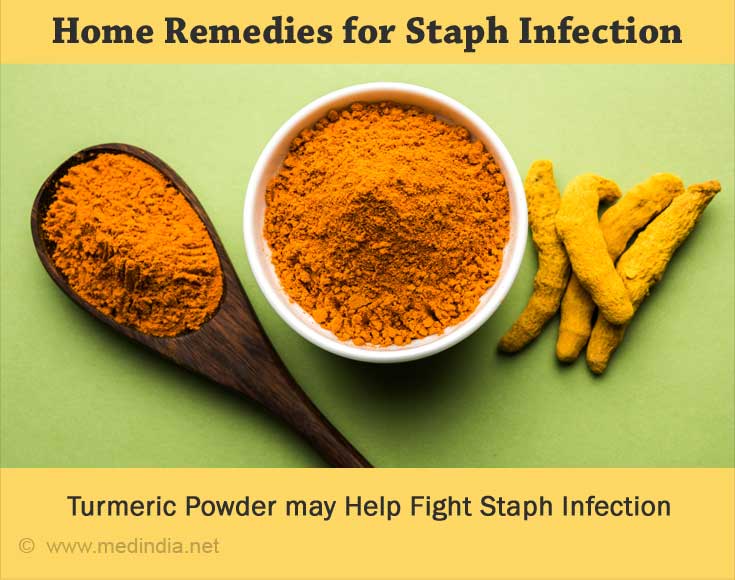Staphylococcus aureus infection or staph infection as it is commonly known occurs when staph bacteria enter the body through bruised skin infecting skin and blood. The staphylococcus bacteria usually beside on the outer skin, nose and genitals not affecting the person normally. But a cut or wound on the skin might lead bacterial strains to enter the skin and bloodstream causing serious infections. It results in redness, swelling, itching, pus-filled boils and painful rashes on the body mostly affecting the face and neck (1✔ ✔Trusted Source
Staphylococcus Aureus
Go to source).
S. aureus are one of the most common bacterial infections in humans and causes multiple human infections, including bacteremia, infective endocarditis, skin and soft tissue infections (e.g. impetigo), osteomyelitis, septic arthritis, pulmonary infections (e.g., pneumonia), gastroenteritis, meningitis, and urinary tract infections (2✔ ✔Trusted Source
Staphylococcus aureus infections: epidemiology, pathophysiology, clinical manifestations, and management
Go to source).
Methicillin-resistant Staphylococcus aureus (MRSA) is another strain of staph bacteria that is resistant to many antibiotics and cannot be treated by medication easily. Staph infection is extremely contagious and is spread by direct skin contact with the infected person and objects (3✔ ✔Trusted Source
Methicillin Resistant Staphylococcus Aureus
Go to source). A scientific study indicates that MRSA is responsible for 10-fold more infections than all multi-drug resistant (MDR) Gram-negative pathogens combined (4✔ ✔Trusted Source
Methicillin-resistant Staphylococcus aureus (MRSA): antibiotic-resistance and the biofilm phenotype
Go to source).
What Causes Staph Infection?
Staph bacteria enter through a cut or bruised skin. Direct skin contact with staph bacteria can be due to various factors such as:
- Contact with infected person’s exposed skin
- Using infected objects, towels, clothes, utensils, etc
- Drug abuse - injecting infected needles
- Low immunity due to any medical condition
- Using an internal medical device such as catheter, feeding tube or fitted artificial joint
- Sharing gym and sports equipment
- Long duration of hospital stay (5✔ ✔Trusted Source
Staphylococcus aureus Infections: Epidemiology, Pathophysiology, Clinical Manifestations, and Management
Go to source)
All these may result in serious staph infection on skin and other body organs. Staphylococcus infection is generally treated by antibiotic medicines, however, in recent times bacteria are getting progressively resistant to different antibiotics posing a difficulty in treating the infection. The MRSA strain of staph bacteria is hard to treat with antibiotics (6✔ ✔Trusted Source
Treatment of Staphylococcus aureus Infections
Go to source). Hence, alternative options are useful in tackling the infection. Here are some home- based natural remedies for staph infection.
Disclaimer: The home remedies suggested here are not a substitute for treatment by doctors. It is highly advisable to seek an expert’s opinion. All the remedies listed here may not be suitable for everyone. It is recommended to check for allergies or do a patch test before using the remedy.
Home Remedies for Staph Infection
There are certain home remedies that can help improve immunity of the body. However these are not a substitute to treatment by the doctors.- Turmeric: Curcumin, the major constituent of turmeric has antibiotic and anti-inflammatory properties and may help with staph infection. A tonic made of turmeric powder mixed with black pepper, water and coconut oil taken several times a day is helpful in curing the infection. Turmeric powder mixed with lime powder and water can also be applied as a paste on the affected area to reduce the pain and redness. It dries up the pus in the blister and reduces infection. A scientific study proves that the antibacterial properties of turmeric is effective against both methicillin resistant S.aureus (MRSA) and methicillin sensitive S.aureus (MSSA) (7✔ ✔Trusted Source
Antibacterial Action of Curcumin against Staphylococcus aureus: A Brief Review
Go to source)

- Coconut oil: Coconut oil has a lasting soothing effect on blistered and itchy skin. Its antibacterial properties help in reducing infection and healing skin gently. Apply a dab of coconut oil on blisters for cooling effect and faster cure. A study concluded that coconut oil might be used as an alternative to antibiotics and as a modulator of the cellular immune system (8✔ ✔Trusted Source
Antibacterial and immunomodulator activities of virgin coconut oil (VCO) against Staphylococcus aureus
Go to source).
- Apple cider vinegar: It is shown to have anti-bacterial and antifungal properties that effectively help lessen the infection. Cotton soaked in apple cider vinegar applied over an infected region or mix with baking soda and apply it as a paste to rapidly reduce pain and discomfort. A mixture of apple cider vinegar in honey and water if consumed two to three times a day helps to alleviate the pain and overcome the infection (9✔ ✔Trusted Source
Antimicrobial activity of apple cider vinegar against Escherichia coli, Staphylococcus aureus and Candida albicans; downregulating cytokine and microbial protein expression
Go to source).

- Tea tree oil: Another bactericidal herb is tea tree. Its oil is known to decrease the growth of bacteria reducing the effects of staph infection. A mixture of tea tree oil and honey may help in preventing growing staph bacteria and soothing boils. Apply a few drops of tea tree oil to help reduce pain and itching due to staph infection on the face (10✔ ✔Trusted Source
Melaleuca alternifolia (Tea Tree) Oil: a Review of Antimicrobial and Other Medicinal Properties
Go to source). - Castor oil: Castor oil helps healing of staph infection as a result of its anti-inflammatory and anti-microbial properties. It provides warmth to infected areas drying out the pus and relieving pain. Apply some warm castor oil with a cotton swab on the wound and cover it lightly with bandage or flannel cloth. This will provide necessary warmth to the wound and help with healing (11✔ ✔Trusted Source
Characterization and evaluation of antibacterial and antiproliferative activities of crude protein extracts isolated from the seed of Ricinus communis in Bangladesh
Go to source).

- Basil: Basil is a proven preventive against numerous infections. Daily intake of a few basil leaves in tea is recommended to improve immunity. Fresh basil leaves extracted into juice is applied on the affected area to help treat staph infection. It helps reduce various symptoms related to staph infection such as redness, itching and prevent them from increasing. Basil oil can also be used for the infection (12✔ ✔Trusted Source
Comparative studies on the activity of basil--an essential oil from Ocimum basilicum L.--against multidrug resistant clinical isolates of the genera Staphylococcus, Enterococcus and Pseudomonas by using different test methods
Go to source). - Eucalyptus oil: According to a study, the essential oils of Eucalyptus globulus is a natural antibiotic for the treatment of several infections caused by S.aureus. Eucalyptus yields oil rich in terpenoids such as eucalyptol and cineole which are antimicrobial, anti-inflammatory and expectorant in nature. Such a therapeutic profile makes it suitable for treatment against a wide range of bacteria. It is considered as a good broad-spectrum antiseptic herb for antibiotic-resistant bacteria like MRSA. Prepare a tea by boiling a few drops of eucalyptus oil in water and drink it 2 times a day to help with staph infection or apply it directly over the affected area (13✔ ✔Trusted Source
Antibacterial activity of the essential oils from the leaves of Eucalyptus globulus against Escherichia coli and Staphylococcus aureus
Go to source).
- Goldenseal: Leaves of goldenseal show antibiotic properties helpful in treating various infections and related symptoms. It is also effective against staph infection, boils and impetigo. A scientific study suggests that goldenseal leaf contain several constituents that act against MRSA. Wash the infected area with goldenseal powder mixed with water several times in a day to reduce pain and discomfort (14✔ ✔Trusted Source
Quorum Quenching and Antimicrobial Activity of Goldenseal (Hydrastis canadensis) against Methicillin-Resistant Staphylococcus aureus (MRSA)
Go to source). - Witch hazel: Witch hazel is anti-bacterial and antimicrobial in nature having anti-inflammatory properties. It also acts as an astringent which sterilizes the skin preventing further bacterial infection. Apply witch hazel mixed with water to infected area for relief from redness, bursting blisters and pain. Regular witch hazel bath prevents microbial infections and keeps skin healthy. Witch hazel is effective against bacterial infection in both acute and chronic conditions (15✔ ✔Trusted Source
Witch Hazel Significantly Improves the Efficacy of Commercially Available Teat Dips
Go to source).

- Ginger and Manuka honey: A paste made of crushed ginger and salt in manuka honey can help in treating a staph infection. It stops further bacterial growth and decreases infection. Apply it over the affected area 2-3 times a day to efficiently reduce the symptoms and speedy cure (16✔ ✔Trusted Source
Manuka honey microneedles for enhanced wound healing and the prevention and/or treatment of Methicillin-resistant Staphylococcus aureus (MRSA) surgical site infection
Go to source).
These home remedies may be beneficial in treating staph infections and reducing their symptoms. They can lessen pain and prevent bacterial growth naturally and are effective even against antibiotic-resistant strains like MRSA on which most antibiotics fail to act. Do try out these easy and simple home remedies for staph infection or use them along with the prescribed antibiotics. .
 MEDINDIA
MEDINDIA

 Email
Email








How do I get mamuku honey